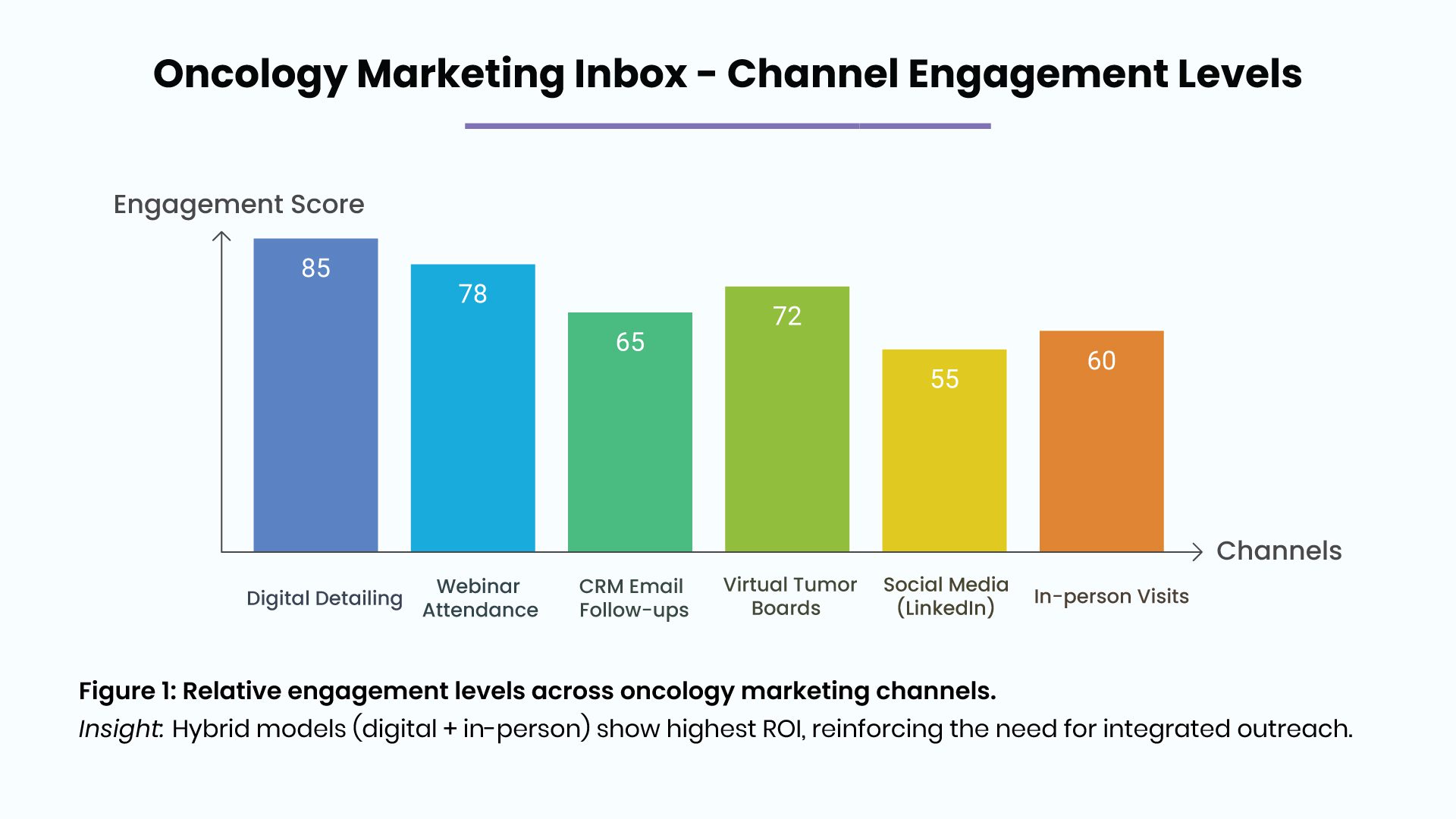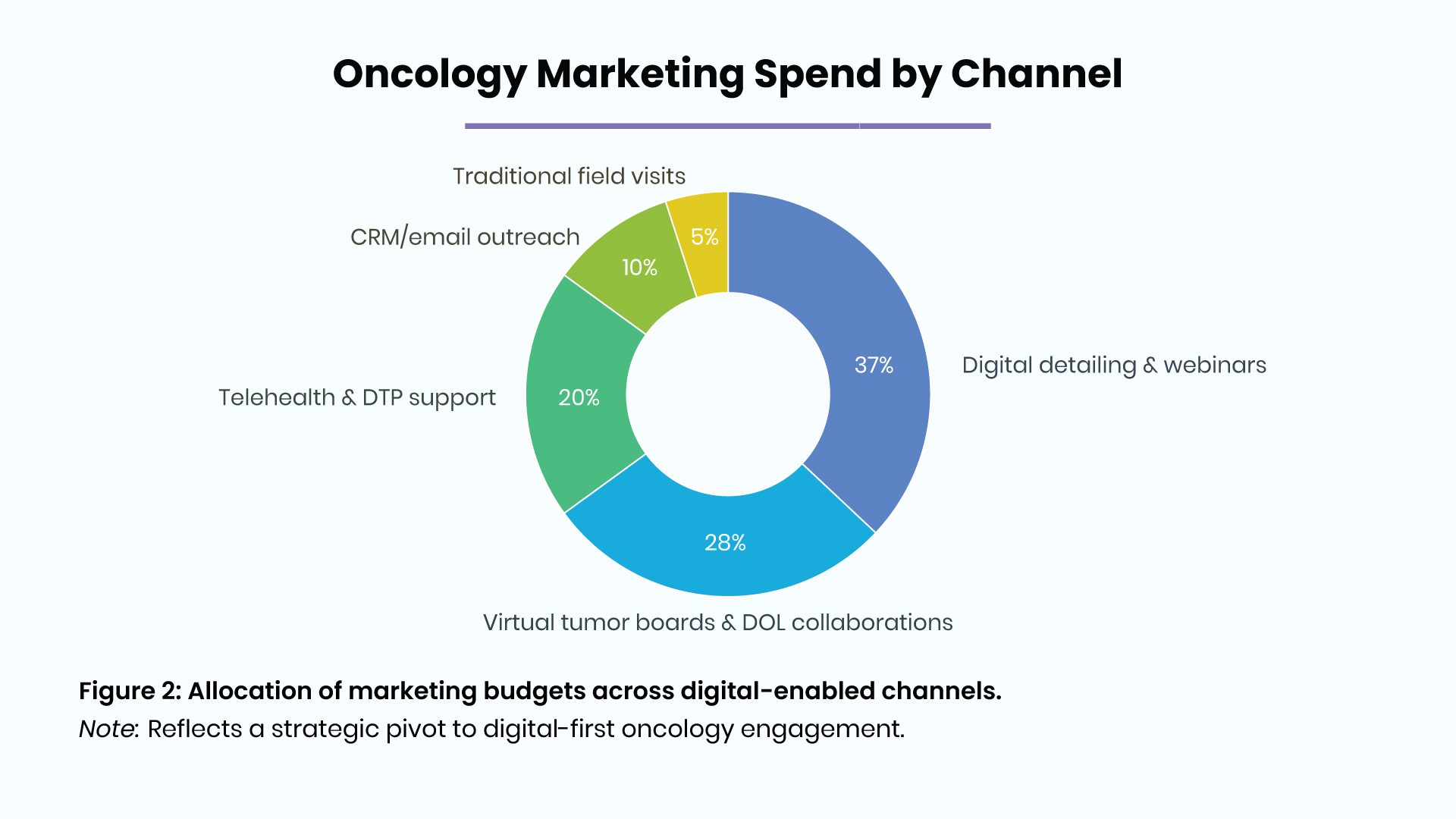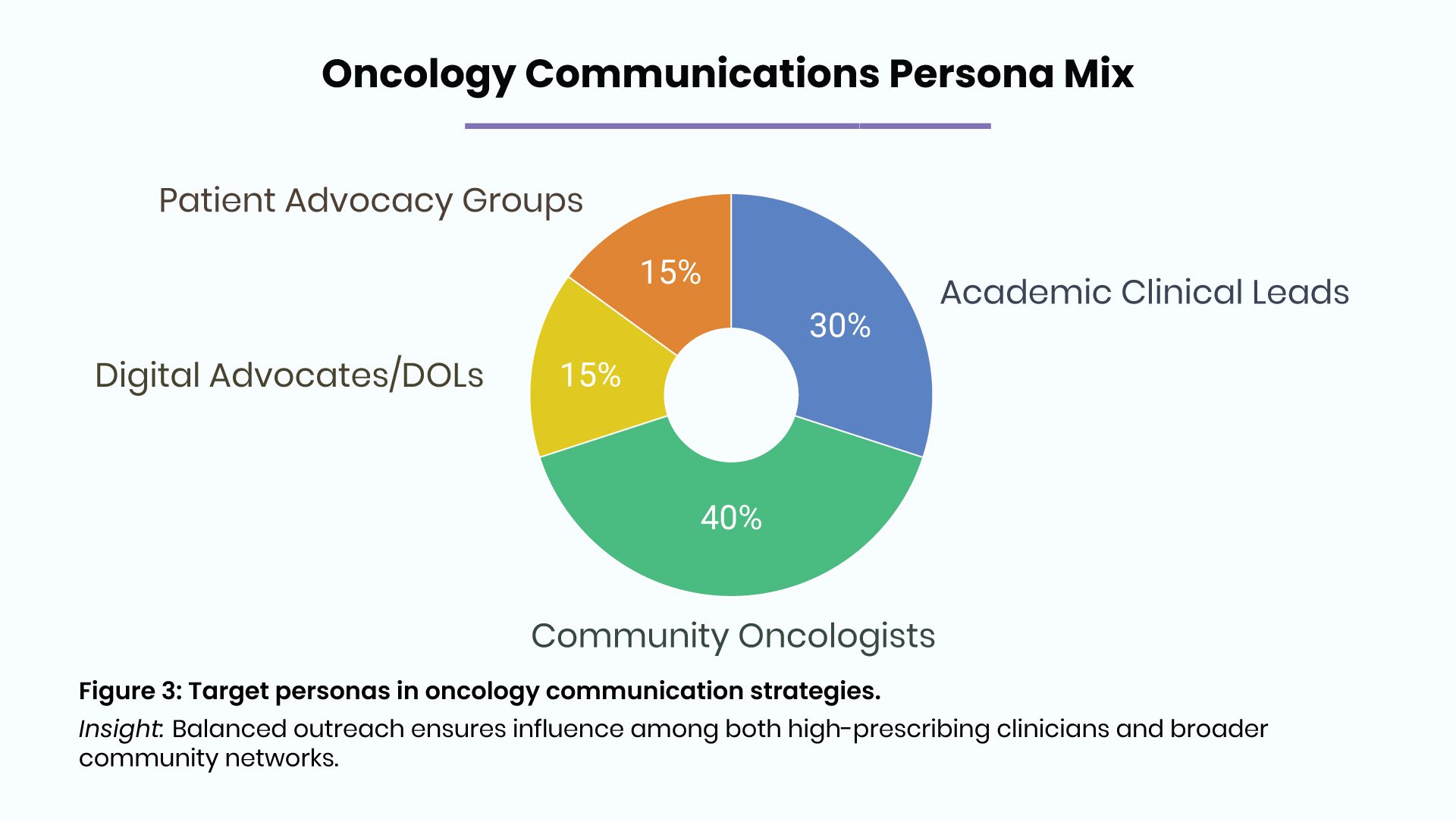Introduction
The landscape of oncology pharma marketing is evolving rapidly. Traditional field force tactics are giving way to digital-first strategies that prioritise Digital Opinion Leaders (DOLs), AI-driven hyper-personalisation, and patient-centric digital pathways, including direct-to-patient engagement. This article delves into how pharma companies can harness these trends to build deeper oncology brand ecosystems while maintaining ethical rigor and regulatory compliance.
1. The Rise of Digital Opinion Leaders (DOLs) in Oncology
While KOLs Key Opinion Leaders remain influential, their digital counterparts (especially on LinkedIn, Twitter, clinician forums) are increasingly shaping medical conversations. A marketing shift towards DOLs is gaining momentum.
Why DOLs matter in oncology:
- They provide real-time, peer-level validation of therapy innovations.
- Their content resonates with busy oncologists who rely on quick, credible insights.
Best-in-Class DOL Engagement Strategies:
- Network mapping: identify emerging oncology voices via social listening and publishing activity.
- Continuous interaction: partner with DOLs on webinars, journal clubs, or virtual tumor boards year-round, not just at launch.
- Amplification: once co-created, DOL content (e.g., case studies, mini-lectures) is distributed across CRM, email, and social channels for maximized reach.
This organic, peer-to-peer approach builds trust and scientific credibility, crucial in oncology’s evidence-driven sphere.
2. AI-Powered Hyper-Personalization: Reaching Oncologists Where They Are
Generic campaigns no longer cut it. AI-driven personalisation is setting a new standard in pharma marketing, especially in oncology, where decisions hinge on scientific nuance.
How AI Enables Precision Outreach:
- Micro-segmentation: oncologists segmented by subspecialty (e.g., thoracic, GI, hematologic), prescribing patterns, trial participation, etc.
- Triggered journeys: webinar attendance or content downloads prompt automated follow-ups e.g., targeted case summary emails or peer interviews via CRM/marketing platforms.
- Behavioral signal analysis: monitoring salt downloads, time spent on tool portals, virtual detailing opens, followed by tailored messaging.
Result: communications feel relevant, timely, and personal, enhancing engagement and therapeutic positioning.

3. Patient-Centric Digital Pathways & Direct-to-Patient (DTP)
Oncology brands increasingly invest in end-to-end patient support from diagnosis through treatment and beyond. DTP models exemplify this trend.
Key Components of Patient-Centric Campaigns:
- Education portals: branded microsites offering treatment guides, side-effect profiles, and patient stories.
- Telehealth integration: partnerships (e.g., LillyDirect, PfizerForAll) enable patients to schedule appointments, access nurse lines, and order treatment at home.
- Medication adherence tools: companion apps, reminder systems, symptom trackers, ideally integrated with physician portals.
- Chatbots/AI agents: address FAQs, provide treatment insights and care navigation 24/7.
These pathways support patients emotionally and logistically, and establish pharma as a trusted companion in care journeys.
4. Compliance & Ethics: Navigating a Complex Ecosystem
With AI, influencers, and DTP come heightened compliance scrutiny from the U.S. FDA/EMA to GDPR and HIPAA.
Compliance essentials:
- Transparency: Disclose paid partnerships with DOLs and influencers in every asset.
- Data governance: Secure first-party data usage, maintain explicit opt-ins, and ensure compliance with local data laws.
- Pre-approved modular content: AI-generated messages and dynamic ads must utilize MLR-reviewed blocks to avoid inconsistent claims.
- Audit-ready tracking: Every automated journey and patient touchpoint must be traceable.
Adhering to these standards preserves credibility and mitigates regulatory risk.

5. ROI Measurement: Tying Engagement to Prescription
Understanding what works, beyond clicks and attendance, is key in oncology.
Measurement models include:
- Closed-loop attribution: CRM logs webinar attendance or portal usage, then matches with Rx fill data.
- Predictive analytics: AI models predict which oncologists are likely to switch therapy; early engagement signals correlated with prescription increases.
- Peer influence tracking: Gauging reach and impact of DOL content via shares, comments, citations, or referral leads.
This data-driven loop optimises tactics, reallocates spend in near-real time, and tightens ROI.
6. Future Horizons: Next-Gen Oncology Marketing
6.1 Generative AI for Content at Scale
- Auto-generation of video abstracts, summaries, chatbot responses, and educational visuals moderated by compliance teams.
6.2 AI-Optimised DOL Matching
- AI platforms evaluate digital reach, credibility, and fit to match DOLs to oncology campaigns.
6.3 Virtual Tumour Boards as CME Assets
- Hosting virtual tumour board series (co-branded with DOLs or institutions) offering CME credit, and real clinical exchange.
6.4 Advanced Patient Feedback Loops
- Real-time symptom tracking via digital therapeutics → content adjusted dynamically informed by patient-reported outcomes.
7. AI-Enhanced Content Tagging & Modular Asset Reuse
6.5 Ethical AI in Oncology Marketing
Addressing algorithmic bias and ensuring equity in personalisation across diverse oncologist and patient demographics.

7. AI-Enhanced Content Tagging & Modular Asset Reuse
AI-powered auto-tagging enables pharmaceutical marketers to streamline content management, especially critical when dealing with thousands of digital assets across campaigns. For instance, a global pharma leader implemented Viseven’s solution and achieved a 60% reduction in manual tagging, yielding 340% ROI and dramatically accelerating time-to-market.
How it works:
- Strategic model training: The AI learns the brand’s taxonomy, covering indications, therapeutic areas, and formats from existing tagged assets, ensuring alignment with internal content classification.
- Contextual LLM enrichment: Large language models generate nuanced tags that embed deeper meaning, like “non-small cell lung cancer” or “advisory board video”.
- Seamless DAM integration: Every new asset is auto-tagged upon upload to the Digital Asset Management system, while legacy content is batch-processed for retroactive tagging.
Key benefits:
- Rapid asset reuse: Tagged content can be efficiently assembled into compliant bundles or campaigns, minimising duplicate work.
- Compliance assurance: Accurate tagging, especially on indication-specific content, reduces the risk of off-label messaging and ensures Medical-Legal-Regulatory (MLR) visibility .
- Workflow acceleration: With tagging automated, marketing and medical teams save time previously spent searching and organizing assets.
- Insight-driven iteration: Metadata allows visibility into asset performance, letting teams identify high-performing modules for reuse.
In oncology marketing, where precision-supported materials are essential and updates occur frequently, AI-backed tagging ensures that brand teams can quickly assemble campaigns around new clinical data, append regional label adjustments, or customize for digital outreach, all within an MLR-controlled framework. This results in higher quality digital experiences, faster campaign launches, and more consistent messaging across channels.
8. Predictive ROI Modeling for Budget Optimization
Predictive ROI modeling marks a shift from retrospective campaign reporting to real-time investment decision-making. By integrating historical spend, physician engagements, prescription data, and competitive intelligence into machine learning frameworks, pharma marketers can forecast the financial impact of each marketing channel before launching.
For example, Quantzig’s Marketing Mix Modeling (MMM) helped a major pharma client reduce marketing costs by 60%, while generating $2 million in incremental profit, and reclaiming visibility on underperforming channels. Another Quantzig case for a U.S. pharma firm achieved similar outcomes—holistic spend visibility across digital and traditional channels, optimized media allocation, and measurable ROI uplift
Core capabilities:
- Spend-to-script attribution: Models correlate spend on webinars, detailing, symposia with script starts and refills, isolating highest-yield activities.
- Synergy detection: Insights reveal when channels complement each other—e.g., a KOL webinar enhancing the effectiveness of digital detailing .
- Dynamic reallocation: Real-time dashboards enable marketers to shift budgets mid-campaign toward channels with rising ROI.
- Incremental finance insight: The firm-level model allows marketing and finance teams to simulate “what-if” scenarios for new launches, patent cliffs, or price changes.
In oncology, where marketing budgets are significant and the market responds sharply to data or approvals, predictive ROI modeling allows proactive decision-making. Teams can evaluate the marginal benefit of adding virtual tumor boards, increasing DOL campaigns, or scaling digital detailing. The result is better resource efficiency, stronger brand performance, and tighter alignment between marketing spend and medical outcomes—all while safeguarding compliance through transparent analytics and MLR oversight.
9. AI-Powered Omnichannel Next‑Best‑Action (NBA) Journey Planning
Next‑Best‑Action (NBA) represents a groundbreaking shift in pharma–oncology engagement. Rather than deploying standard campaign cadences, NBA employs AI algorithms to evaluate real-time data, prescribing trends, event attendance, digital interactions, and even competitor activities, to compute the most effective action at every moment.
How it operates:
- Building comprehensive HCP profiles: Data from CRM call logs, webinar attendance, prescriptions, and content consumption are integrated into unified HCP dashboards. AI continuously analyses this 360° profile to detect attention, timing, and preferred formats.
- Predictive scoring and rule-augmented AI: Dual-layered NBA systems combine supervised models with heuristic rules (NBA 2.0), resulting in decisions like: “Rep calls Dr. X now because of recent spillover growth in prescribing and recent webinar attendance.” This beats static schedules.
- Channel orchestration: Recommendations specify channels (video call, email, peer event invite) and optimise timing. If a rep’s scheduled meeting falls through, NBA automatically suggests an alternative HCP nearby.
- Performance-feedback loop: HCP responses to NBA-driven outreach open, actions taken, and prescriptions — are fed back to the AI engine, which refines future suggestions and tracks ROI impact.
Benefits in oncology:
- Precise attention delivery: When HCPs receive better-targeted touchpoints, engagement rises, firms report engagement uplifts of 15–25% and prescription gains of a similar size.
- Salesforce productivity gain: Reps avoid low-yield activities, focusing instead on high-opportunity interactions, time is better spent, and the budget is more efficient.
- Omnichannel coordination: Integrating by channel allows marketers to exploit the complementary effect,s e.g., emails warm up the lead before a follow-up peer event.
- Compliance-assured execution: NBA tools can be configured to only deploy MLR-approved messages per channel and context, satisfying regulatory oversight.
In oncology, where data-driven decisions, rapid evidence updates, and busy schedules collide, NBA delivers the right message to the right oncologist at the right time, and through the right channel. This not only increases HCP satisfaction but also ties field engagement quantitatively to prescription lift, making NBA indispensable for brand teams.
Conclusion
Oncology pharma marketing is at a pivotal inflexion point, shaped by digital advocacy, AI-fueled personalisation, and patient-centric digital models. Organisations that adopt these approaches, while staying rigorously compliant, will not only improve brand engagement but also meaningfully contribute to the cancer-care ecosystem.
By leveraging DOL-driven peer influence, AI-first communications, and integrated patient experience hubs, marketers can elevate oncology brands into trusted partners in clinical and patient-first settings.
Key Takeaways
- Harness DOLs: map and collaborate with peer influencers in real time.
- Implement AI journeys: personalise every touchpoint from content triggers to CRM engagement.
- Build patient-first pathways: enable telehealth, adherence support, and symptom tracking.
- Be compliance-first: transparency, data privacy, and MLR-governed content are non-negotiable.
- Measure holistically: link engagement to Rx results, and refine swiftly with real‑time analytics.
The Oncodoc team is a group of passionate healthcare and marketing professionals dedicated to delivering accurate, engaging, and impactful content. With expertise across medical research, digital strategy, and clinical communication, the team focuses on empowering healthcare professionals and patients alike. Through evidence-based insights and innovative storytelling, Hidoc aims to bridge the gap between medicine and digital engagement, promoting wellness and informed decision-making.



